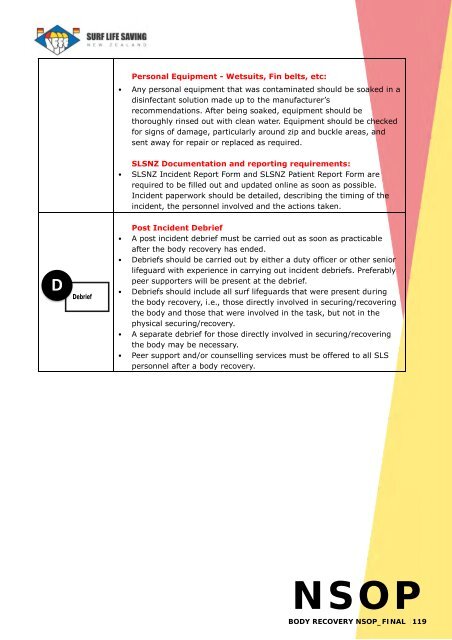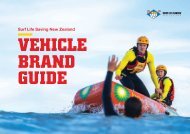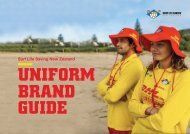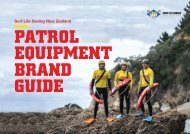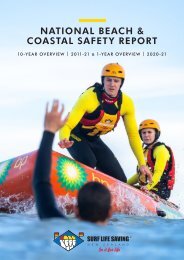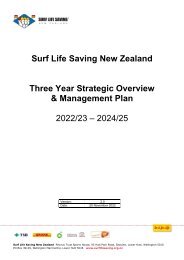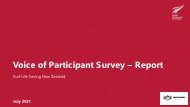National Standard Operating Procedures - Jul 2022
Full NSOP Manual
Full NSOP Manual
Create successful ePaper yourself
Turn your PDF publications into a flip-book with our unique Google optimized e-Paper software.
E<br />
S<br />
C<br />
U<br />
Emergency<br />
Services<br />
Situation<br />
Communicate<br />
Undertake<br />
Operation<br />
• Contact Police via 111 or SurfCom in any situation that requires a low<br />
light response<br />
• Request air support with illumination<br />
• Gather as much information and intelligence about the incident from<br />
informant or emergency services as possible<br />
• Keep informants at scene. Document their phone number and those of<br />
the missing if possible<br />
• Undertake a SLSNZ Search and Rescue Risk Assessment by using the<br />
SLSNZ Search and Rescue ORA application. In particular, consider and<br />
assess:<br />
- Moon state<br />
- Available celestial light<br />
- Surf conditions<br />
- Availability of shoreline illumination and spotters<br />
• Develop clear mission and objectives (GSMEAC) and place a time limit<br />
on the amount of time the IRB/ RWC will be at sea<br />
• DO NOT PROCEED IF:<br />
- Probability of detection is lower than 5%<br />
- Surf Size exceeds 1m or Unable to see breaking surf<br />
- Unable to identify breaking surf on rock features<br />
- Unsure about personal limitations to handle conditions<br />
- The SLSNZ Search and Rescue Risk Management Matrix exceeds 15<br />
• Conduct team briefing (GSMEAC) before deploying<br />
• Contact Coastguard/SurfCom/Police before launching<br />
• Conduct radio checks before deployment and file trip report (TR) with<br />
Coastguard stating:<br />
o Call sign<br />
o Number of persons on board<br />
o Intentions<br />
o Expected return time<br />
• Handover and liaise with other services using the ISBAR communication<br />
tool<br />
• Communicate frequently throughout the incident<br />
• Provide updates to SLSNZ staff when able<br />
• Ensure all team equipped with correct PPE for the task and environment<br />
• Apply a Dynamic Risk Assessment or ORA. Think about crew fatigue and<br />
poor to no light conditions<br />
• Consider requesting a modified task or refusing the task if requested<br />
task exceeds team’s capabilities or safety concerns. Document applying<br />
a Dynamic Risk Assessment or ORA<br />
• Document all details of the crew responding out to sea and pass to<br />
Police and SurfCom<br />
• Request additional support if required early with Police (e.g., Rescue<br />
helicopter)<br />
• Conduct radio checks before deployment<br />
• Develop a Comms plan by assigning call signs to each craft before<br />
deploying<br />
• Conduct Search and Rescue/SAROP within limits of team’s skill,<br />
experience and abilities<br />
• Record operational details (times, places searched, etc.). NOTE: this<br />
record may be used as evidence<br />
NSOP<br />
LOW LIGHT - NIGHT OPERATIONS NSOP_FINAL 112


